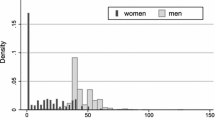Abstract
The paper develops a model of family size decisions in which couples choose explicitly a combination of mother's time and purchased childcare (e.g. childminders, nannies) for the care and rearing of children. The theoretical model implies that the impact of the mother's wage on her completed fertility varies with the market price of childcare, and that this effect increases (becoming less negative or more positive) with the level of her wage. Econometric analysis of British micro-data confirms the main predictions of the model.
Similar content being viewed by others
References
Becker GS (1981) A treatise on the family. Harvard University Press, London
Becker GS, Lewis HG (1973) On the interaction between the quantity and quality of children. J Polit Econ 81:S279-S288
Ermisch JF (1986) Economics of the family: applications to divocre and remarriage. Centre for Economic Policy Research Discussion Paper No. 140, London
Ermisch JF (1988) Econometric analysis of birth rate dynamics in Britain. J Hum Resources 23:563–575
Ermisch JF, Wright RE (1987) Women's wages in full- and part-time jobs in Great Britain. Center for Economic Policy Research Discussion Paper, London
Heckman J (1979) Sample selection bias as a specification error. Econometrica 47:153–161
Joshi H (1986) Participation in paid work: evidence from the women and employment survey. In: Blundell R, Walker I (eds) Unemployment, search and labour supply. Cambridge University Press, Cambridge, pp 217–242
Joshi H, Layard PRG, Owen S (1985) Why are more women working in Britain? J Labour Econ 3:S147-S176
Lam D (1988) Marriage markets and assortative mating with household public goods. J Hum Resources 23:462–487
Maddala G (1983) Limited dependent and qualitative variables in econometrics. Cambridge University Press, Cambridge
Martin J, Roberts C (1984) Women and employment: A lifetime perspective. Her Majesty's Stationary Office, London
Willis RJ (1973) A new approach to the economic theory of fertility. J Polit Econ 81:S14-S69
Author information
Authors and Affiliations
Additional information
I am grateful to Robert E. Wright for research assistance, and to the Economic and Social Research Council for supporting this research as part of the research programme ‘Income Inequality, Gender and Demographic Differentials’. Financial support from the Nuffield Foundation grant no. PT/9, ‘Family Formation and Employment Activity” is also gratefully acknowledged.
Rights and permissions
About this article
Cite this article
Ermisch, J.F. Purchased child care, optimal family size and mother's employment Theory and econometric analysis. J Popul Econ 2, 79–102 (1989). https://doi.org/10.1007/BF00522403
Received:
Accepted:
Issue Date:
DOI: https://doi.org/10.1007/BF00522403




